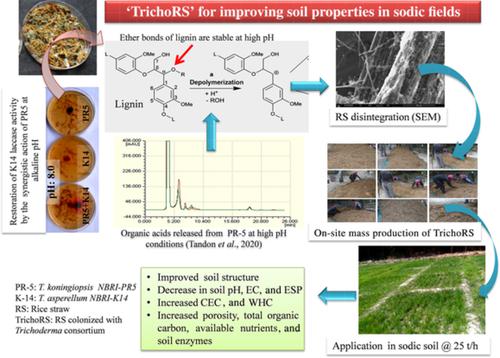当前位置:
X-MOL 学术
›
Land Degrad. Dev.
›
论文详情
Our official English website, www.x-mol.net, welcomes your
feedback! (Note: you will need to create a separate account there.)
Trichoderma-primed rice straw alters structural and functional properties of sodic soil
Land Degradation & Development ( IF 3.6 ) Pub Date : 2021-11-14 , DOI: 10.1002/ldr.4151 Ashmita Tandon 1, 2 , Anshu Anshu 1, 3 , Sanjeev Kumar 1, 2 , Udit Yadav 1, 2 , Shashank K. Mishra 1 , Suchi Srivastava 1, 2 , Puneet S. Chauhan 1, 2 , Pankaj K. Srivastava 4 , Lal Bahadur 5 , P. A. Shirke 6 , Manjoosha Srivastava 7 , Shri Krishna Tewari 8 , Poonam C. Singh 1, 2
Land Degradation & Development ( IF 3.6 ) Pub Date : 2021-11-14 , DOI: 10.1002/ldr.4151 Ashmita Tandon 1, 2 , Anshu Anshu 1, 3 , Sanjeev Kumar 1, 2 , Udit Yadav 1, 2 , Shashank K. Mishra 1 , Suchi Srivastava 1, 2 , Puneet S. Chauhan 1, 2 , Pankaj K. Srivastava 4 , Lal Bahadur 5 , P. A. Shirke 6 , Manjoosha Srivastava 7 , Shri Krishna Tewari 8 , Poonam C. Singh 1, 2
Affiliation

|
Sodic soil is increasing due to intensive cropping and imbalanced use of agrochemicals. Therefore, the objective of the present study was to reduce the soil sodicity in agricultural fields using sustainable resources. The ‘microbe–residue–soil’ interaction is hypothesized to foster the structural and functional changes during sodic soil reclamation. To elucidate the hypothesis, rice straw (RS) assimilation in sodic soil was instated in the presence of synergistically interacting Trichoderma koningiopsis NBRI-PR5 (PR5) and T. asperellum NBRI-K14 (K14) consortium. The interaction of the ‘microbe-residue-soil’ was investigated in-vitro and in sodic fields. Our studies included estimation of soil physicochemical properties, enzymes, CO2 efflux using LI-COR, microbial population, scanning electron microscopy, and Fourier-transformed infrared spectroscopy (FTIR) analysis. The compatibility and synergism of PR5 assisted the K14 to produce laccase enzyme at high pH condition (pH 8) to degrade RS in sodic soil. For in vitro and field applications, Trichoderma were colonized on RS (TrichoRS) and applied at 25 t ha−1. Impact of TrichoRS on soil was evident from decreased soil pH (9.6 to 7.8), exchangeable sodium percent (19.6 to 9.9%), increased soil porosity (~53% from 38%), and cation exchange capacity (~twofold). The FTIR showed differences in the stretching of O-H bonds at 3750–34500 cm−1 indicating the presence of more kaolinite-type silicates after TrichoRS amendment. Field application of TrichoRS increased the total organic carbon and water-holding capacity from 0.37% to 1.3% and 34% to 57%, respectively. Increased microbes and urease, protease, and phosphatase activity by 2.72-, 0.94-, and 0.88-times, respectively, ensured nutrient availability. The improved soil properties and ~ 30% increased production justify the hypothesis in providing sustainable reclamation solution for reviving fertility of sodic and intensively cultivated fields.
中文翻译:

木霉引发的稻草改变了钠质土壤的结构和功能特性
由于集约化种植和农用化学品的不平衡使用,钠质土壤正在增加。因此,本研究的目的是利用可持续资源减少农田的土壤碱度。假设“微生物-残留物-土壤”相互作用会促进钠质土壤复垦过程中的结构和功能变化。为了阐明这一假设,在协同相互作用的Trichoderma koningiopsis NBRI-PR5 (PR5) 和T. asperellum NBRI-K14 (K14) 联合体存在的情况下,在钠质土壤中建立了稻草 (RS) 同化。“微生物-残留物-土壤”的相互作用在体外和钠田中进行了研究。我们的研究包括估计土壤理化性质、酶、CO 2使用 LI-COR、微生物种群、扫描电子显微镜和傅里叶变换红外光谱 (FTIR) 分析的流出物。PR5的相容性和协同作用有助于K14在高pH条件下(pH 8)产生漆酶来降解钠质土壤中的RS。对于体外和现场应用,木霉属在RS (TrichoRS)上定殖并以25 t ha -1施用。从土壤 pH 值降低(9.6 到 7.8)、可交换钠百分比(19.6 到 9.9%)、土壤孔隙度增加(从 38% 增加到 53%)和阳离子交换容量(约两倍),TrichoRS 对土壤的影响很明显。FTIR 显示 3750–34500 cm -1处 OH 键的拉伸存在差异表明在 TrichoRS 修正后存在更多的高岭石型硅酸盐。TrichoRS 的现场应用使总有机碳和持水能力分别从 0.37% 提高到 1.3% 和 34% 提高到 57%。微生物和脲酶、蛋白酶和磷酸酶活性分别提高了 2.72 倍、0.94 倍和 0.88 倍,确保了养分的有效性。改善的土壤特性和约 30% 的产量增加证明了提供可持续开垦解决方案以恢复苏打和集约耕地的肥力的假设。
更新日期:2021-11-14
中文翻译:

木霉引发的稻草改变了钠质土壤的结构和功能特性
由于集约化种植和农用化学品的不平衡使用,钠质土壤正在增加。因此,本研究的目的是利用可持续资源减少农田的土壤碱度。假设“微生物-残留物-土壤”相互作用会促进钠质土壤复垦过程中的结构和功能变化。为了阐明这一假设,在协同相互作用的Trichoderma koningiopsis NBRI-PR5 (PR5) 和T. asperellum NBRI-K14 (K14) 联合体存在的情况下,在钠质土壤中建立了稻草 (RS) 同化。“微生物-残留物-土壤”的相互作用在体外和钠田中进行了研究。我们的研究包括估计土壤理化性质、酶、CO 2使用 LI-COR、微生物种群、扫描电子显微镜和傅里叶变换红外光谱 (FTIR) 分析的流出物。PR5的相容性和协同作用有助于K14在高pH条件下(pH 8)产生漆酶来降解钠质土壤中的RS。对于体外和现场应用,木霉属在RS (TrichoRS)上定殖并以25 t ha -1施用。从土壤 pH 值降低(9.6 到 7.8)、可交换钠百分比(19.6 到 9.9%)、土壤孔隙度增加(从 38% 增加到 53%)和阳离子交换容量(约两倍),TrichoRS 对土壤的影响很明显。FTIR 显示 3750–34500 cm -1处 OH 键的拉伸存在差异表明在 TrichoRS 修正后存在更多的高岭石型硅酸盐。TrichoRS 的现场应用使总有机碳和持水能力分别从 0.37% 提高到 1.3% 和 34% 提高到 57%。微生物和脲酶、蛋白酶和磷酸酶活性分别提高了 2.72 倍、0.94 倍和 0.88 倍,确保了养分的有效性。改善的土壤特性和约 30% 的产量增加证明了提供可持续开垦解决方案以恢复苏打和集约耕地的肥力的假设。











































 京公网安备 11010802027423号
京公网安备 11010802027423号